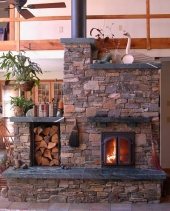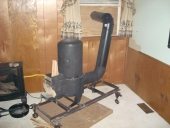posted 8 years ago
In my house anyway, of the wood burning stove, the wood/coal boiler, and my propane boiler; the propane boiler is the safest of the three in terms of carbon monoxide.
That is because for safety sake it takes in air from the outside of my house, heats it, then returns it out through the exhaust stack. Because it is a closed loop that does not use air inside my home, it is simply the safest for me and my family. If drafting problems, or components in the appliance fail, the computer instantly shuts down the appliance.
Of the other two stoves, the wood/coal boiler is the next safest because it has a variable speed forced draft eliminating drafting issues on damp, low pressure days, or windy days and like the propane boiler, draws air from outside my home.
My non-EPA compliant 1893 wood burning stove is the least safest only because drafting in that heating appliance can be tricky. I live on a hill so wind is more of an issue then damp low pressure days, but as I type this my eyes are watery from smoke as we just went from a VERY windy day yesterday to dead calm now. I was forced to use the damper to keep the high wind from down drafting the chimney and chuffing smoke into the house yesterday. I woke up with it closed and not drafting up the chimney this morning, so it shows it is very temperamental. Also, unlike my other two heating appliances, it draws air from INSIDE my home.
...
In terms of fuel safety which is another issue entirely, there is no question that a house full of wood does not explode. Here in Maine we do not have much natural gas as it is Propane making it a bit safer as elements are added to make it smell in case of a leak. In 23 years of having back up propane however I have never had a leak. Within propane there are two sides; the liquid side, and then the gas side, and of the two the liquid side is much safer. Should a leak develop, the propane is so cold that it instantly freezes when it hits atmosphere. Then it thaws. Then it freezes. Then it thaws, and so it goes until the product is dispensed. 99% of the time a liquid propane leak for first reponders is to just wait until the problem resolves itself. On the gas side, it is a little more volatile, but people have a unhealthy fear of it when they really shouldn't. My father was an appliance repair man for years and would often check for leaks with a lighter. A leak would blow the flame of his lighter out...not blow up. There is only 11 inches of pressure at an appliance, and the volume of propane to air is so low that combustion is impossible. Now a room pumped full of propane...yes that would blow up, but is very rare, modern regulators are designed to prevent that very thing from happening. Now I have heard of (2) houses in Maine exploding from propane explosions in the last 10 years, yet on my hill alone, of 5 houses, mine has been the only one that has not had a major fire from a wood stove. Three have burned completely to the ground, including my parents.
As for coal, coal explosions can and do happen, and I have experienced one in 23 years of burning the black rock. For the record this has always been Anthracite coal and not Bituminous or Lignite coal which have a bit more coal gas within it than Anthracite. In my case the explosion happened because of my own stupidity. I was burning coal merrily away and wanted to try a coal/pellet mix to see if I could get extended burn times. When I shoveled in a few pounds of pellets over the burning coal bed, I did not have time to mix the material before the coal gas coming off the coal bed built up, but with ample heat inside the stove, it blew up. It was not huge, and my stove pipe riveted together easily handled the fireball going up the chimney, but I experienced it. But it was 100% my stupidity that caused it and not from normal coal burning.
Safety wise, coal is MUCH safer than wood only because there is no creosote with coal so it is impossible to have a chimney fire. Equally, once the coal is bed is burning, it will slowly begin to dwindle as it begins to plug with ash. This is in contrast to wood that can smoulder for awhile in a wood stove, then suddenly roar to life once certain burn conditions are met. In other words I can leave my home with a coal fire going knowing it will never suddenly roar to life an hour after I am gone. It will only burn in proportion to the amount of air and coal I give it; very predictable.
...
In short propane, natural gas and coal are "safer" only because they are more consistent in content. Because of that, human controls to move and consume the products have been developed over many years of development. However I am not at all advocating for them. With consistency and control over the product, comes control over the product line, and living in Maine I spend too much money to heat my house every year no matter what with, to be held hostage by high prices to any one heating product. Propane is safe and easy, but also expensive. Coal is cheaper, but still comes from a supplier. Wood comes from my own land, but is less safe. Still, for me and my family, I am going to mitigate those safety concerns as best I can, run with scissors like I did in kindergarten, and do the best I can to provide for myself by heating with wood for the majority of my heating needs.
I do not have a Rocket Mass heater so I cannot state experience on them, however they burn wood. Wood is an inconsistent product so it has a lot of unknowns, but I would not say they are inherently dangerous either. Mitigate potential problems and move on without fear...

 2
2































 2
2































 2
2
















 1
1








 1
1






































